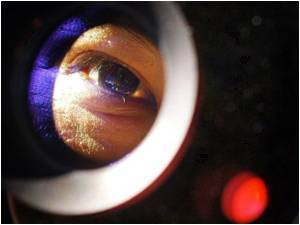A research team led by St. Jude Children's Research Hospital scientists has identified a potential new target for treatment of the childhood eye tumor retinoblastoma. Their work also

Researchers also demonstrated that multiple, normally incompatible, developmental pathways are turned on simultaneously in retinoblastoma tumor cells. These pathways guide the fate of developing cells and determine what types of cells they become. This study found the tumor takes over at least one pathway to fuel its own growth, making it a promising drug development target.
The research provides additional insight into this rare tumor of the retina and is expected to advance understanding of retinoblastoma as well as aid development of more targeted therapies, said Michael Dyer, Ph.D., a member of the St. Jude Department of Developmental Neurobiology and the study's senior author. Justina McEvoy, Ph.D., and Jacqueline Flores-Otero, Ph.D., are co-first authors of the study and postdoctoral fellows in Dyer's laboratory.
Retinoblastoma is a tumor of the retina, which is the light-sensing membrane at the back of the eye. The tumor is found in about 5,000 individuals worldwide each year, mostly infants and toddlers. Although cure rates exceed 95 percent for patients whose cancer is contained in the eye, the prognosis is bleak if the tumor has spread.
For more than a century, scientists have tried to link the tumor's origins to one of the seven different types of cells that make up the retina. Although researchers have presented evidence to support various candidates, Dyer said the answer has remained elusive. Identifying where the tumor begins would likely speed efforts to develop new chemotherapy drugs. Increasingly, such agents are designed against particular molecular pathways active in cancer cells.
For this study, researchers took a comprehensive, unbiased approach to the search that included molecular, cellular and chemical analyses of tumor cells. Dyer and his colleagues reported that retinoblastoma tumors in both humans and mice include features from several different types of cells in the retina. The list includes cells called amacrine and horizontal interneurons, retinal progenitor cells and photoreceptors.
Advertisement
Screening data are now available at no cost for use by other scientists at http://www.ncbi.nlm.nih.gov/geo/query/acc.cgi?acc=GSE29686, "The finding that normal developmental programs are completely deregulated in this tumor is surprising and unexpected. It could also have therapeutic implications," Dyer said.
Advertisement
Scientists went on to show that blocking chemicals called monoamine neurotransmitters, which nerve cells normally use for communication, reduced growth in human retinoblastoma cells growing both in the laboratory and the eyes of mice. Dyer said the drugs used in this study, the anti-psychotic agents fluphenazine and chlorpromazine, better known as Thorazine, are unlikely to be used for treatment of retinoblastoma, but offer a starting point for future drug development.
The research also demonstrated that tumors transplanted directly from a patient into the same location in the eye of a mouse retained characteristics of the human tumor. The findings strengthen use of this approach for screening drugs for possible use against human cancers.
Source-Eurekalert











